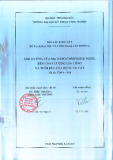
Hindawi Publishing Corporation
EURASIP Journal on Advances in Signal Processing
Volume 2011, Article ID 875132, 14 pages
doi:10.1155/2011/875132
Research Article
A Complexity-Reduced ML Parametric Signal
Reconstruction Method
Z. Deprem,1K. Leblebicioglu,2O. Arıkan,1and A. E. C¸etin
1
1Department of Electrical and Electronics Engineering, Bilkent University, Bilkent, Ankara, 06800, Turkey
2Department of Electrical and Electronics Engineering, Middle East Technical University, Ankara, 06531, Turkey
CorrespondenceshouldbeaddressedtoZ.Deprem,zdeprem@ee.bilkent.edu.tr
Received 2 September 2010; Revised 8 December 2010; Accepted 24 January 2011
Academic Editor: Athanasios Rontogiannis
Copyright © 2011 Z. Deprem et al. This is an open access article distributed under the Creative Commons Attribution License,
which permits unrestricted use, distribution, and reproduction in any medium, provided the original work is properly cited.
The problem of component estimation from a multicomponent signal in additive white Gaussian noise is considered. A parametric
ML approach, where all components are represented as a multiplication of a polynomial amplitude and polynomial phase term, is
used. The formulated optimization problem is solved via nonlinear iterative techniques and the amplitude and phase parameters
for all components are reconstructed. The initial amplitude and the phase parameters are obtained via time-frequency techniques.
An alternative method, which iterates amplitude and phase parameters separately, is proposed. The proposed method reduces
the computational complexity and convergence time significantly. Furthermore, by using the proposed method together with
Expectation Maximization (EM) approach, better reconstruction error level is obtained at low SNR. Though the proposed method
reduces the computations significantly, it does not guarantee global optimum. As is known, these types of non-linear optimization
algorithms converge to local minimum and do not guarantee global optimum. The global optimum is initialization dependent.
1. Introduction
In many practical signal applications involving ampli-
tude and/or phase-modulated carrier signals, we encounter
discrete-time signals which can be represented as
s[n]=a[n]ej∅[n],(1)
where a[n]and∅[n] are the real amplitude and phase
functions, respectively. Such signals are common in radar,
sonar applications, and in many other natural problems. A
multicomponent [1] signal is a linear combination of these
types of signals and is given by
s[n]=
L
i=1
ai[n]ej∅i[n],(2)
where si[n]=ai[n]ej∅i[n]is the ith component and Lis the
number of components. Clearly, the linear decomposition
of the multicomponent signal in terms of such components
is not unique. Some other restrictions should be put on
the components to have a unique decomposition [1]. In
general, a component is the part of the multicomponent
signal which is identifiable in time, in frequency, or in mixed
time-frequency plane. Therefore, we will assume that the
different components are well separated in time-frequency
plane and have a small instantaneous bandwidth compared
to separation between components.
The main problem is to separate the components from
each other or to recover one of the components. In general
the approaches for the solution are those which use non-
parametric time-frequency methods and those of parametric
ones. In case where the desired signal component is separable
or disjoint in one of time or frequency domain, then, with
some sort of time or frequency masking, the component can
be estimated. When the signals are disjoint either in time
or in frequency domain, then time-frequency processing
methods are needed for component separation. But, in some
cases even though the components are not separated in time
or in frequency, the Fractional Fourier Transform [2–4]can
be used to separate the components at the fraction, where
they are disjoint.
Time Frequency Distribution- (TFD-) based waveform
reconstruction techniques, for example, the one in [5],

2 EURASIP Journal on Advances in Signal Processing
synthesize a time-domain signal from its bilinear TFD. In
these algorithms, a time-domain signal whose distribution is
close to a valid TFD, in a least-squares sense, is searched for.
The well-known time-frequency method is the Wigner-
Distribution [6] based signal synthesis [5,7–9]. The main
drawback related to time-frequency methods is the cross-
terms and resolution of the time-frequency representations
[10]. Therefore, there have been many efforts to obtain cross-
term-free and high-resolution TFDs [11–13].
In parametric model a signal or component is repre-
sented as a linear combination of some known basis func-
tions [14,15], and the component parameters are estimated.
In many radar and sonar applications the polynomials are
good basis functions.
If the phase and amplitude functions in (1)arepoly-
nomials and amplitude function is constant or slowly
varying, the Polynomial Phase Transform (PPT) [14,16]is
a practical tool for parameter estimation. While the method
is practical, it has difficulties in time-varying amplitude and
multicomponent cases [17]. It is also suboptimal since the
components are extracted in a sequential manner.
Another solution is the ML estimation of the parameters.
The related method is explained in [15,17]. The ML esti-
mation of the parameters requires a multivariable nonlinear
optimization problem to be solved. Therefore, the solu-
tion requires iterative techniques like nonlinear conjugate
gradient (NL-CG) or quasi-Newton-type algorithms and is
computationally intensive [15,17]. Another requirement is
a good initial estimate which avoids possible local minima.
But it estimates all parameters as a whole and is optimal in
this respect. Also it does not suffer from cross-terms related
to time-frequency techniques.
In [14] an algorithm is explained which extracts the
components using PPT in a sequential manner. In [18]a
mixed time-frequency and PPT-based algorithm is proposed.
The examples with the ML approach are given in [15,17].
In this paper a method is proposed which uses ML
estimation. Similar to [18], the initial estimates are obtained
from time-frequency representation of the multicomponent
signal and then all parameters are estimated by ML estima-
tion. Since ML estimation requires large amount of computa-
tion, a method is proposed to reduce the computations. The
proposed method iterates amplitude and phase parameters
separately by assuming that the other is known. The method
is different from the ones given in [15,17], where the
amplitude parameters are eliminated analytically and the
resultant equivalent cost function is minimized.
Eliminating amplitude parameters analytically results in
a cost function which has less number of parameters. But
it is computationally more complex in terms of function
and gradient evaluations, which are needed in nonlinear
optimization iterations.
With the proposed method, since the cost functions for
separate amplitude and phase parameters are less complex,
the amount of computation is reduced compared to case
where amplitude parameters are eliminated analytically. Fur-
thermore, by using the proposed method in an expectation
maximization loop, a better reconstruction error level is
obtained. The results are verified with simulations.
In Section 2 we describe the notation and give the
explanation of the ML estimation approach which is given
in [15]. In Section 3 we describe the proposed method.
In Section 4 we compare the computational cost of the
proposed method with the case where amplitude parameters
are eliminated analytically. In Section 5 we give a brief expla-
nation of Expectation Maximization (EM) and how to use
the proposed alternating phase and amplitude minimization
method in an EM loop. In Section 6 we drive the Cramer-
Rao Bounds on mean square error related to component
reconstruction. In Section 7 we present the simulation
results. First taking Cramer-Rao bounds as the reference we
compare the proposed method with the one given in [15]in
terms of mean square reconstruction error and then compare
their performance in terms of computational cost.
2. Problem Formulation and ML Estimation
Let x[n] be a discrete-time process consisting of the sum of
a deterministic multicomponent signal and additive white
Gaussian noise given by
x[n]=
L
i=1
ai[n]ej∅i[n]+w[n],n=0, 1, ...,N−1,(3)
where w[n] is the complex noise process. Denoting gk[n]and
pk[n] as the real-valued basis functions for amplitude and
phase terms, respectively, we will have
ai[n]=
Pi
k=0
ai,kgk[n],(4)
∅i[n]=
Qi
k=0
bi,kpk[n],(5)
where ai,kand bi,kare the real valued amplitude and phase
coefficients for the ith component. Similarly Pi+1and
Qi+ 1 are the number of coefficients for amplitude and
phase functions of the ith component. In general, basis
functions can be any functions which are square integrable
and spans the space of real and integrable functions in a given
observation interval. Also they can be selected to be different
for amplitude and phase and for each component. In this
paper they are assumed to be polynomial for both amplitude
and phase and for all components. Therefore, Piand Qi
corresponds to orders for amplitude and phase polynomials
of the ith component, respectively.
Defining the amplitude and phase coefficients of the ith
component by the vectors
ai=ai,0 ai,1 ai,2 ··· ai,PiT,
bi=bi,0 bi,1 bi,2 ··· bi,QiT,
(6)
we can define parameter vectors for all the components as
a=aT
1aT
2aT
3··· aT
LT,
b=bT
1bT
2bT
3··· bT
LT.
(7)

EURASIP Journal on Advances in Signal Processing 3
We will use the following notation
x=x[n]=x[0]x[1]x[2]··· x[N−1]T,(8)
where
n=[0, 1, 2, ...,N−1]T,
w=w[n]=w[0]w[1]w[2]··· w[N−1]T,
ej∅i[n]=ej∅i[0] ej∅i[1] ej∅i[3] ··· ej∅i[N−1]T,
(9)
where the bold characters n,x,w,andej∅i[n]are all N×1
vectors. With these definitions the following matrices can be
defined
Φi=g0[n]•ej∅i[n]g1[n]•ej∅i[n]g2[n]
•ej∅i[n]··· gPi[n]•ej∅i[n],
(10)
Φ=[Φ1Φ2Φ3···ΦL], (11)
where “•”in(
10) denotes component-by-component mul-
tiplication of vectors. ΦisareN×(Pi+1)matriceswhich
contain the phase parameters only and are defined for each
component. The matrix Φis an N×L
i=1(Pi+1)matrix
and again contains the phase parameters for all components.
With these definitions the expression in (3)canbewrittenin
matrix notation as
x=Φa+w.(12)
In this equation the amplitude parameter vector aenters the
equation in a linear way, while the phase parameter vector b
enters the equation in nonlinear way through Φ.
Now the problem is to estimate combined parameter
vector θ=[bTaT]Tgiven observed data vector x=
x[0] x[1] x[2] ··· x[N−1]T. It is assumed that the
observed data length Nis sufficiently greater than the total
number of estimated parameters given by M=L
i=1{(Pi+
1) + (Qi+1)}.
The number of components, since components are
assumed to be well separated on TFD, can be estimated from
TFD. But here we will assume that Lis known. Similarly Pi
and Qiare assumed to be known. A method to estimate them
can be found in [14,16].
With the additive white Gaussian noise assumption, the
probability density function (pdf) of data vector x, given the
parameter vector θand logarithmic likelihood function, is
given by
p(x|θ)=1
(πσ2)Nexp−1
σ2x−Φa2, (13)
Λ=log p(x|θ)=−N(ln π+2lnσ)−1
σ2x−Φa2,
(14)
where σ2is the noise variance? Since xand Φare com-
plex, by defining x=Re{x}TIm{x}TTand Ψ=
Re{Φ}TIm{Φ}TT, the log-likelihood function can be
rewritten in real quantities as
Λ=−N(ln π+2lnσ)−1
σ2x−Ψa2.(15)
Maximizing log likelihood in (15) corresponds to minimiz-
ing f(a,b)=
x−Ψa2.Foragivenphasevectorb, this
cost function is quadratic in amplitude vector a. Therefore,
amplitude vector acan be solved analytically as
a=ΨTΨ−1ΨTx.(16)
Using this separability feature of the parameter set and
substituting (16)in(15) the original log-likelihood function
can be replaced by
Λ=−N(ln π+2lnσ)−1
σ2J(b), (17)
where
J(b)=xTP⊥
Ψx, (18)
P⊥
Ψ=I−PΨ, (19)
PΨ=ΨΨTΨ−1ΨT.(20)
While the original cost function was a function of aand b,
thisnewaugmentedfunctionisafunctionofbonly. Like
the original cost function this new cost function J(b) is also
nonlinear in b. Therefore, minimization requires iterative
methods like nonlinear conjugate gradient or quasi-Newton-
type methods. These iterative methods require also a good
initial estimate to avoid possible local minima. In [15] initial
estimates are obtained by PPT. After bis solved iteratively, a
is obtained by (16).
3. Proposed Method for Iterative Solution
The separability feature of the original cost function in (15)
allows us to reduce the number of unknown parameters
via analytical method. Since the resultant cost function
is just a function of phase parameters, we will call this
method Phase-Only (PO) method. Though PO deals with
reduced set of parameters, the resultant cost function J(b)is
highly nonlinear and more complicated in terms of function
and gradient evaluations. This is a disadvantage when the
minimization of the reduced cost function is to be obtained
via nonlinear iterative methods. Therefore, in this paper,
an alternative method is proposed. The method carries out
two minimization algorithms in an alternating manner. The
method divides the original minimization problem given by
(15) into two subminimizations. The idea is to find one
parameter set assuming that the other set is known. First
assuming that the initial phase estimate
b0is known, the cost
function
fa(a)=fa,
b0=
x−
Ψ0a
2(21)

4 EURASIP Journal on Advances in Signal Processing
is formed and minimized, and a solution a1is obtained,
where
Ψ0is the matrix obtained by initial phase parameter
estimate
b0. Then using this amplitude estimate a1asecond
cost function
fb(b)=fa1,b=
x−Ψa1
2(22)
is formed and minimized, and a solution
b1is found.
These two minimizations constitute one cycle of proposed
algorithm. By repeating this cycle, taking
b1as the new
initial phase estimate, the estimates a2and
b2are obtained.
By repeating the cycles sufficiently many times, the final
estimates a∗and
b∗are obtained as shown in
b0−→ a1−→
b1−→ a2−→
b2−→ a3−→
b3···a∗−→
b∗.
(23)
The cost function for amplitude parameters fa(a)is
quadratic. Therefore, the solution can be obtained either
analytically or via conjugate gradient (CG). But the cost
function for phase parameters fb(b) is nonlinear. Therefore,
we need to use nonlinear methods.
The proposed method, which we will call, from now
on, Alternating Phase and Amplitude (APA) method, is a
generalization of the so-called coordinate descent method
[19], where the minimization of a multivariable function
is done by sequentially minimizing with respect to a single
variable or coordinate and keeping the others fixed. By
cyclically repeating the same process a minimum for the
function is searched. A generalization of coordinate descent
method is the Block Coordinate Descent (BCD) method,
where the variables are separated into blocks containing
more than one variable and the minimization is done over
a block of variables and keeping the others fixed. In our case
we have two blocks, and the minimization over one block
is quadratic. Though the indications on the convergence of
similar algorithms are given in [19], the theoretical proof
regarding the convergence of proposed method is beyond the
scope of this work, and we will content with the simulation
results.
The main trick with proposed algorithm is that during
amplitude and phase minimizations we do not have to
find the actual minimum. What we are looking for is a
sufficient improvement from the current estimate that we
have. Therefore, for the phase iterations rather than iterating
down to the convergence point we can iterate a sufficient
number of iterations to get some improvement. The same
is valid for the minimization of fa(a)ifwedecideto
use conjugate gradient. But overall alternating phase and
amplitude iterations will allow us to converge to a minimum.
The first minimization can be chosen to be the minimization
of fb(b) instead of fa(a). Then the sequence in (23) will start
by a0. The decision about which one to start with should be
based on which initial parameter vector, a0or
b0,ismore
close to its actual. This cannot be known in advance, but,
based on success of the method by which the initial estimates
a0and
b0are obtained, a decision can be given.
Like J(b), fb(b) is also nonlinear, and we need iterative
methods like nonlinear conjugate gradient or quasi-Newton.
These methods converge to local minimum and do not
guarantee global minimum unless initial estimates are
sufficiently close to global optimum. Therefore, we need to
find a method which gives us initial estimates. While in
[15] initial estimates are obtained by PPT, in this paper we
obtained the initial estimates from time-frequency methods.
The time-frequency distribution we used is the Short-Time
Fourier Transform (STFT).
At first cycle, the phase iterations will be started by
b0=
bTF where
bTF is the estimate obtained from time-frequency
method. In later cycles, the previous cycle estimates will
be used. If minimization of fa(a) is done analytically, then
we will not need any initial value. But, if we decide to use
iterative methods again, we can use initial estimate a0=aTF
obtained from time-frequency method.
As we stated before we assume that the different compo-
nents are well separated in time-frequency plane and have
a small instantaneous bandwidth; that is, the components
are not crossing each other. Therefore, by using magnitude
STFT, the ridges of each component are detected on TF
plane. The algorithm detects the ridges on TF plane by
detecting local frequency maximums for each time index.
Also by using a threshold the effect of noise is reduced, and
the IF is detected at points where component is stronger
than noise. Therefore, even though when the weak end of
some components is interfering on TF plane with some
other stronger component, the IF of stronger component is
detected at that point, but the week part of other components
is not detected. But the estimates obtained with this method,
though they are not the best ones, will be sufficient as initial
parameters.
Then from the ridges the instantaneous frequency (IF)
samples (
fi[n]) for each component are estimated and by
polynomial fit corresponding polynomial is obtained. Then
by integrating this polynomial the phase function
∅i[n]
and polynomial coefficients
bTF
ifor each component are
obtained. By dechirping x[n]bye−j
∅i[n]and low-pass
filtering the result, the amplitude estimate ai[n] is obtained
for each component. Again by polynomial fit aTF
iis obtained
for each component. The overall steps for the proposed APA
algorithm are summarized in Tabl e 1.
The initial estimates are obtained from signal TFD by
steps 1–5 given in Tabl e 1. Some other methods could also
be used. But in this paper the main focus is on the last
step. Therefore, though the steps 1–5 were implemented, the
efficiency and performance of this part have not been studied
in detail. The only concern was to get initial estimates which
are close enough to actual values to avoid local minima if
possible. But it should be noted that for the comparison
purposes the same initial conditions will be used for the
proposed APA algorithm and the phase-only method given
in [15].
An important issue that we need to question is the
uniqueness of the solution to the optimization problem in
(15). Since we express a component in terms of amplitude
and phase functions and these functions are expressed in
terms of basis functions, we need to question the uniqueness
of the global optimum at three levels.

EURASIP Journal on Advances in Signal Processing 5
Starting form last level, given a phase function ∅i[n],
uniqueness of the parameter vector bifor this function can
be assured if the base functions pk[n], k=0, 1, ...,Qi,are
independent of each other. The same is valid for amplitude
function ai[n] and parameter vector ai.
Uniqueness at the amplitude and phase function level
(model functions level) will not be assured due to phase
ambiguity, because if ai[n]and∅i[n]constituteacompo-
nent then −ai[n]and∅i[n]+πwill also constitute the same
component. Therefore, even though aiis unique for ai[n]
and biis unique for ∅i[n], the pair ai[n]and∅i[n]willnot
be unique for si[n] and, as a result, θi=[bT
iaT
i]Twill not
be unique for si[n]. This shows that the global optimum is
not unique in terms of model functions, hence in terms of
parameter vector θ=[bTaT]T.
On the other hand uniqueness at signal si[n]orcom-
ponent level will be possible if the components are well
separated on TFD [1]. In simple terms if no component is
coinciding at the same time-frequency point with some other
component then the components which constitute the sum
in (2) can be found uniquely. Two extreme cases are those
where all components are separated in time domain or in
frequency domain.
Therefore, even though uniqueness is not satisfied at
model functions level hence at parameter level, it can be
satisfied at component or signal level with the restrictions
on time-frequency plane. In fact, the solution ambiguity
in model or parameter space will not affect the final
performance of the component reconstruction as long as
the combination of model functions or model parameters
gives the same signal or component. In our case we extract
the initial parameters for a component from related TF
area which is disjoint. Therefore, assuming that the initial
parameters are close enough to global optimum, we use
these restrictions, which will make the component level
uniqueness possible, at the beginning.
On the contrary to the assumptions made on time
frequency support of components, in simulations, one
example (Ex2) is selected such that the components are
slightly crossing each other. But most of the parts are
nonoverlapping, and these parts allow estimation of an initial
IF which will help uniqueness, because, we have assumed in
Section 2 that the phase orders Qis are also known. With this
assumption, the set of ambiguous IF estimates hence phase
estimates are eliminated for this example, because fitting
other ambiguous IFs to the known polynomial order will
result in higher fit error. Therefore, for similar examples, the
time-frequency restriction can be slightly relaxed.
3.1. Computational Cost Analysis. With the phase-only
method the resultant cost function J(b)isgivenby(
18). For
the sake of computation ease if we reorganize this equation
we will have
J(b)=xTP⊥
Ψx=xTx−ΨTxTΨTΨ−1ΨTx, (24)
where Ψ=[Ψ1Ψ2Ψ3···ΨL]andΨiis given by
Ψi=⎡
⎣Re{Φi}
Im{Φi}⎤
⎦=⎡
⎣g0[n]•Cos(∅i[n])g1[n]•Cos(∅i[n])··· gPi[n]•Cos(∅i[n])
g0[n]•Sin(∅i[n])g1[n]•Sin(∅i[n])··· gPi[n]•Sin(∅i[n])⎤
⎦, (25)
where “•” again denotes component-by-component multi-
plication of vectors.
The gradient of J(b)isgivenby[
15]
∇J(b)=−2xTP⊥
ΨB,(26)
where
B=[B1,B2,...,BL],
Bi=
bi,0,
bi,1,
bi,2,...,
bi,Qi,
bi,k=∂Ψi
∂bi,k
RT
ixk=0, 1, ...,Qi,
R=ΨΨTΨ−1=[R1,R2,...,RL].
(27)
The derivative of Ψiwith respect to bi,kis computed as
follows:
∂Ψi
∂bi,k=
Ψi•Gk, (28)
where
Ψiis the reordered version of Ψigiven by
Ψi=−Im{Φi}
Re{Φi}(29)
and Gkhas the same dimensions as
Ψiandateachcolumn
contains the same 2N×1vectorpk[n]
pk[n]. The multiplication
between
Ψiand Gkis component by component.
With the proposed method, the minimization of fa(a)
either by CG or analytically is relatively easy. Similarly the
computation of fb(b)=
x−Ψa02is also easy. By defining
z=Ψa0=
L
i=1
zi,
zi=Ψia0
i=⎡
⎣Re{Φi
}
Im{Φi
}⎤
⎦a0
i=⎡
⎣ziR
ziI⎤
⎦=
⎡
⎢
⎢
⎢
⎢
⎢
⎢
⎣
Pi
k=0a0
i,kgk[n]•Cos(∅i[n])
Pi
k=0a0
i,kgk[n]•Sin(∅i[n])
⎤
⎥
⎥
⎥
⎥
⎥
⎥
⎦
,
(30)
















![Báo cáo seminar chuyên ngành Công nghệ hóa học và thực phẩm [Mới nhất]](https://cdn.tailieu.vn/images/document/thumbnail/2025/20250711/hienkelvinzoi@gmail.com/135x160/47051752458701.jpg)









